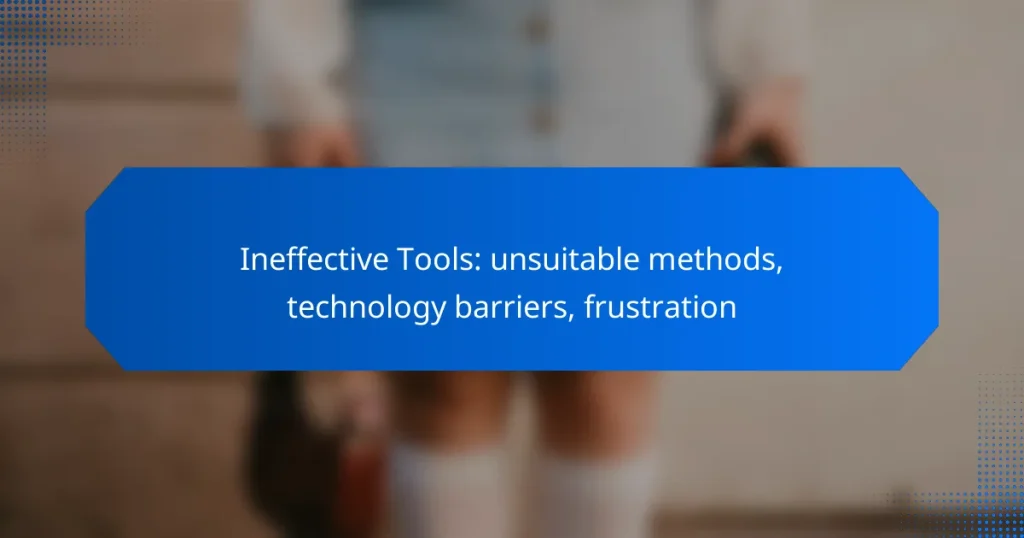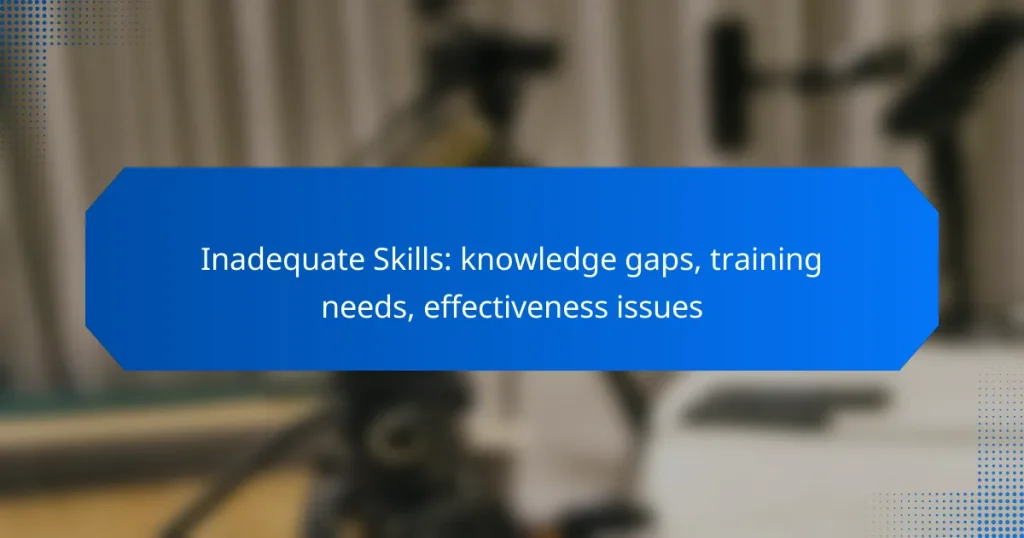Time management is a crucial skill that can greatly influence productivity and overall well-being. However, individuals often face challenges such as procrastination, poor prioritization, and distractions that can impede their ability to manage time effectively. Addressing these issues is essential for enhancing efficiency and reducing stress in both personal and professional settings.
Ineffective Tools: unsuitable methods, technology barriers, frustration
Inadequate Skills: knowledge gaps, training needs, effectiveness issues
What are the common challenges in time management?
Common challenges in time management include procrastination, poor prioritization, distractions, overcommitment, and lack of planning. Each of these issues can significantly hinder productivity and lead to stress, making it essential to address them effectively.
Procrastination
Procrastination is the act of delaying tasks, often leading to last-minute rushes and increased anxiety. It can stem from fear of failure, perfectionism, or lack of motivation. To combat procrastination, set clear deadlines and break tasks into smaller, manageable steps.
Using techniques like the Pomodoro Technique, where you work for 25 minutes and then take a 5-minute break, can help maintain focus and reduce the temptation to procrastinate.
Poor prioritization
Poor prioritization occurs when tasks are not ranked according to their importance or urgency, leading to wasted time on less critical activities. To improve prioritization, consider using the Eisenhower Matrix, which categorizes tasks into four quadrants based on urgency and importance.
Regularly reviewing your to-do list and adjusting priorities as needed can ensure that you focus on what truly matters, helping to enhance productivity.
Distractions
Distractions can come from various sources, including social media, emails, and noisy environments, all of which can disrupt focus and decrease efficiency. Identifying your main distractions is the first step in managing them effectively.
Strategies such as setting specific times to check emails or using apps that block distracting websites during work hours can help minimize interruptions and maintain concentration.
Overcommitment
Overcommitment happens when individuals take on too many responsibilities, leading to burnout and decreased performance. It is crucial to recognize your limits and learn to say no when necessary to maintain a manageable workload.
Assess your current commitments regularly and prioritize tasks that align with your goals. This practice can help prevent overloading your schedule and ensure that you can dedicate adequate time to each task.
Lack of planning
A lack of planning can result in disorganization and missed deadlines. Effective time management requires a clear plan that outlines tasks, deadlines, and priorities. Consider using digital tools or planners to create a structured schedule.
Establishing a weekly review session to plan the upcoming week can help you stay organized and ensure that you allocate sufficient time for each task, reducing the likelihood of last-minute stress.
How can effective time management improve productivity?
Effective time management can significantly enhance productivity by allowing individuals to prioritize tasks, allocate resources efficiently, and minimize distractions. By organizing time effectively, one can achieve more in less time, leading to increased output and better work quality.
Increased focus
Effective time management fosters increased focus by helping individuals allocate specific time blocks for tasks. This structured approach reduces multitasking and distractions, allowing for deeper concentration on the task at hand. For example, using techniques like the Pomodoro Technique, where work is divided into intervals of focused work followed by short breaks, can enhance focus and retention.
To maintain focus, consider setting clear goals for each work session and eliminating potential distractions, such as notifications or social media access during these periods.
Better task completion rates
When time is managed effectively, individuals often experience better task completion rates. By prioritizing tasks based on urgency and importance, one can ensure that critical tasks are completed first, leading to a sense of accomplishment and motivation. Tools like to-do lists or task management apps can help track progress and deadlines.
It’s essential to avoid overloading your schedule; aim for a realistic number of tasks each day to maintain quality and efficiency in your work.
Enhanced decision-making
Effective time management enhances decision-making by allowing individuals to allocate time for reflection and analysis. When time is managed well, there is often more space to weigh options, consider consequences, and make informed choices. This can be particularly beneficial in high-stakes environments where quick decisions are necessary.
To improve decision-making, set aside dedicated time for evaluating options and avoid rushing into decisions without adequate information. This practice can lead to better outcomes and increased confidence in the choices made.
What tools can help with time management?
Several tools can significantly enhance time management by helping individuals organize tasks, set deadlines, and track productivity. Popular options include Trello, Asana, Todoist, and RescueTime, each offering unique features tailored to different needs.
Trello
Trello is a visual project management tool that uses boards, lists, and cards to help users organize tasks. It allows for easy collaboration, enabling team members to assign tasks, set due dates, and add comments. This flexibility makes it suitable for both personal and professional projects.
To get started with Trello, create a board for your project, add lists for different stages, and populate them with cards representing tasks. Consider using labels and checklists within cards to enhance clarity and track progress efficiently.
Asana
Asana is designed for team collaboration and project tracking, offering features like task assignments, due dates, and project timelines. It helps users break down larger projects into manageable tasks, making it easier to monitor progress and meet deadlines.
When using Asana, take advantage of its calendar view to visualize deadlines and prioritize tasks effectively. Additionally, integrating Asana with other tools like Slack or Google Drive can streamline communication and file sharing.
Todoist
Todoist is a task management app that focuses on simplicity and efficiency. It allows users to create tasks, set priorities, and organize them into projects. The intuitive interface makes it easy to capture tasks on the go, whether on a mobile device or desktop.
To maximize Todoist’s effectiveness, utilize its recurring task feature for regular activities and set deadlines to ensure timely completion. Consider using labels and filters to categorize tasks based on context or urgency.
RescueTime
RescueTime is a time-tracking tool that provides insights into how users spend their time on various activities. By automatically tracking computer usage, it helps identify productivity patterns and areas for improvement. This data can be invaluable for making informed adjustments to daily routines.
To use RescueTime effectively, set goals for productive time and receive weekly reports to assess progress. Be mindful of the potential for over-reliance on tracking; balance it with personal reflection on productivity habits for optimal results.
What are the best practices for prioritizing tasks?
Effective task prioritization involves using structured methods to determine which tasks are most important and should be tackled first. By employing strategies like the Eisenhower Matrix, SMART goals, and the ABCDE method, individuals can enhance their time management skills and productivity.
Use the Eisenhower Matrix
The Eisenhower Matrix helps categorize tasks based on urgency and importance, allowing you to focus on what truly matters. It divides tasks into four quadrants: urgent and important, important but not urgent, urgent but not important, and neither urgent nor important.
To apply this method, list your tasks and place them in the appropriate quadrant. For example, a project deadline might fall into the urgent and important category, while checking emails could be urgent but not important. This visual representation aids in making informed decisions about where to allocate your time.
Set SMART goals
SMART goals are specific, measurable, achievable, relevant, and time-bound objectives that clarify what you want to accomplish. This framework ensures that your goals are clear and reachable, which is essential for effective prioritization.
For instance, instead of saying “I want to improve my writing,” a SMART goal would be “I will write 500 words daily for the next month to enhance my writing skills.” This specificity helps you focus on tasks that contribute directly to your objectives.
Implement the ABCDE method
The ABCDE method is a straightforward technique for prioritizing tasks by assigning each task a letter based on its importance. ‘A’ tasks are very important, ‘B’ tasks are important but less so, ‘C’ tasks are nice to do, ‘D’ tasks can be delegated, and ‘E’ tasks should be eliminated.
To use this method, write down your tasks and categorize them accordingly. For example, completing a client report might be an ‘A’ task, while organizing your desk could be a ‘C’ task. This helps streamline your focus on high-priority activities while reducing time spent on less critical tasks.
How can one overcome procrastination?
Overcoming procrastination involves implementing strategies that enhance focus and accountability. By setting clear goals and using effective time management techniques, individuals can significantly reduce delays in task completion.
Set clear deadlines
Establishing clear deadlines helps create a sense of urgency and accountability. When deadlines are specific and realistic, they encourage timely action and reduce the likelihood of procrastination. For instance, instead of saying “I will finish this report soon,” set a deadline like “I will complete this report by Friday at 5 PM.”
To make deadlines effective, consider using reminders or calendar alerts. This keeps the deadline visible and reinforces the commitment to complete tasks on time.
Break tasks into smaller steps
Dividing larger tasks into smaller, manageable steps can make them feel less overwhelming and more achievable. For example, if you need to write a research paper, break it down into steps like selecting a topic, conducting research, outlining, and drafting.
By focusing on one small step at a time, you can maintain motivation and progress steadily. This approach also allows for celebrating small wins, which can further encourage productivity.
Use time-blocking techniques
Time-blocking involves scheduling specific blocks of time for focused work on tasks. This technique helps allocate dedicated periods for each task, minimizing distractions and enhancing concentration. For instance, you might block out 9 AM to 11 AM for writing and 1 PM to 2 PM for meetings.
When using time-blocking, ensure to include breaks to recharge. A common practice is to work for 25 minutes followed by a 5-minute break, known as the Pomodoro Technique. This can help maintain high levels of focus and prevent burnout.


